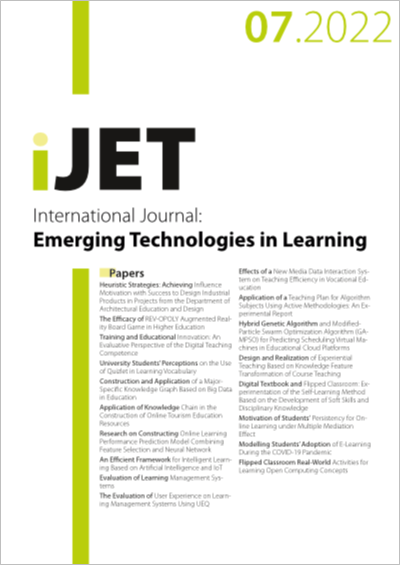Heuristic Strategies: Achieving Influence Motivation with Success to Design Industrial Products in Projects from the Department of Architectural Education and Design
DOI:
https://doi.org/10.3991/ijet.v17i07.25181Keywords:
Achieving influence motivation, Design, Education, Heuristic strategies, Industrial products, Learning, StudentsAbstract
This research aimed to study the achievement of motivation from the learning procedure of heuristic strategies. Besides, it resulted in the success of design product projects from the students in the Department of Architectural Education and Design, King Mongkut’s Institute of Technology Ladkrabang with the learning comparison method and student satisfaction between control groups for normal study and experiment groups with heuristic strategies. This research studied the results from fourth-year student groups studying in the curriculum of Architectural Education and Design. A total of forty-four people were selected by using the observation method and asking for satisfied attributions in the groups to represent the score levels from the personal project assessment. In this case, it also used a 5-point rating scale to make t-test data analysis for Independence with results comparison, and it was found that the experiment group studying with heuristic strategies had the testing scores of the personal project assessment in the higher level than the controlling group with studying in a normal way with statistical significance at the level of .05, including with the reliability assessment from the students in the designing product project, which found that the experiment group with studying for heuristic strategies gaining the reliability level from the personal project at a higher level than the controlling group with studying in a normal way with statistical significance at the level of .05.
Downloads
Published
2022-04-12
How to Cite
Egwutvongsa, S. S., Seviset, S., & Piramgran, T. (2022). Heuristic Strategies: Achieving Influence Motivation with Success to Design Industrial Products in Projects from the Department of Architectural Education and Design. International Journal of Emerging Technologies in Learning (iJET), 17(07), pp. 4–21. https://doi.org/10.3991/ijet.v17i07.25181
Issue
Section
Papers
License
Copyright (c) 2022 Songwut S. Egwutvongsa

This work is licensed under a Creative Commons Attribution 4.0 International License.



